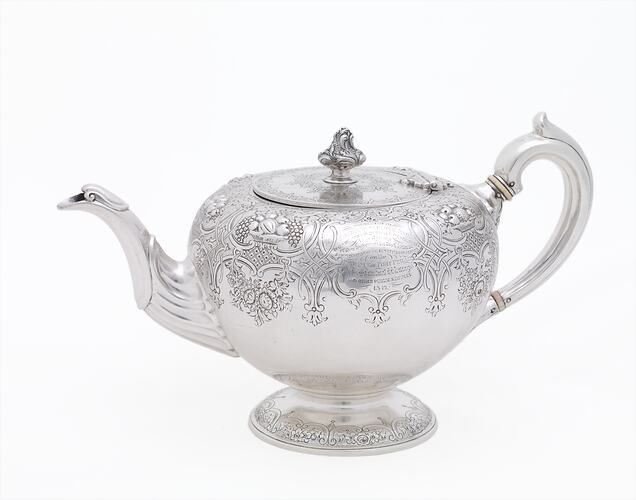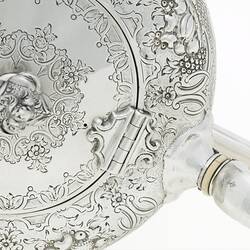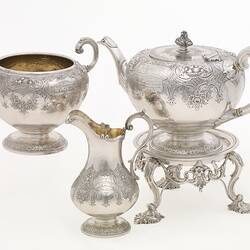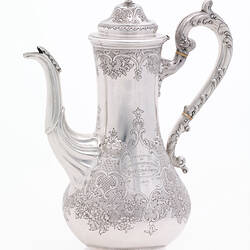Summary
Teapot presented as part of a silver tea and coffee service in 1847 to William Westgarth, a Scottish merchant and financier who was returning to Britain after having played a prominent part in the civic life and affairs of the Port Phillip area from 1840-1847.
The kettle is inscribed 'Presented to William Westgarth Esquire by one hundred and twenty of his fellow colonists in testimony of their high esteem for his character and appreciation of the benefits conferred on the Province of Port Phillip by his statistical writings and other public services, 1847'.
William Westgarth had become a leading merchant and businessman in his seven years in the colony, active in the Benevolent Society and Mechanic's Institute, and written a book publicizing the colony's potential.
Westgarth returned in 1849, helped found the Melbourne Chamber of Commerce in 1851 and was a member of the first Victorian Parliament.
The silver service was made in Edinburgh by J. Mckay, circa 1846, and had probably been imported to Melbourne as a presentation piece.
Physical Description
Ornate silver teapot, large, with impressed decoration and engraved inscription. The teapot was produced as a presentation piece, as there is space on both sides for an engraved insciption to be added within the decoration. A large handle has two small rings of bone to act as insulation and to prevent the handle becoming too hot. The decoration includes flowers, leaves, baskets of fruit, ribbons and scrolls. The lid, which is attached to the body of the tea pot by a hinge, has a 'knob' in an amorphous shape. The teapot is deep, on a silver base; holes are beaten into the silver on the inside to drain the tea through the spout. A detailed inscription is at the front of the pot.
Significance
Melbourne in Melbourne in 1847 was only twelve years old, but already had a site for a Botanic Garden, several churches and a Mechanics Institute. A generation of mostly young men, with some young women, was self-consciously setting out to promote the developing town as a commercial centre and a 'civilised' metropolis.
A prominent resident was William Westgarth, a thirty-two year old Scottish merchant and financier who had been in Melbourne for seven years. He had written a book which publicised the colony's potential overseas, and produced six-monthly reports summarising the commercial and general statistics of Port Phillip. He was active in the Benevolent Society and the Mechanics' Institute, and was a thoughtful commentator on events around him. Westgarth was widely respected for the way he threw himself enthusiastically into making the colony a prosperous and educated place.
When, in January 1847, Westgarth left for Britain on business, a testimonial was opened for him. On the afternoon of Friday April 16, one hundred and twenty subscribers met at the Prince of Wales Hotel and decided to present Westgarth with a silver tea and coffee service. The one they chose had been made in Edinburgh in 1846, and had probably been imported for just such an occasion by a Melbourne jeweller. It is tempting to surmise that they chose Edinburgh silver, rather than a piece made in London, as a compliment to Westgarth's Scottish origins.
The silver service was engraved: Presented to William Westgarth Esquire by one hundred and twenty of his fellow colonists in testimony of their high esteem for his character and appreciation of the benefits conferred on the Province of Port Phillip by his statistical writings and other public services, 1847. This is a rare presentation piece from that period in Melbourne's history when the leaders of the new society mostly all knew each other.
William Westgarth returned to Victoria in 1849 and continued to play a prominent part in public life. He helped found the Melbourne Chamber of Commerce in 1851, and was a member of the first Victorian Parliament. He returned to London in 1857, but retained his interest in Victoria. In 1888 he returned again for the Centennial Exhibition, and presented Victorians with a granite drinking fountain carved in Scotland and featuring kangaroos and emus.
(This information was published in the Museum's Magazine, c. 1999. It draws on material in the Australian Dictionary of Biography, the Argus newspaper, and research files on the Westgarth Fountain within the REB research collection. It was written by Elizabeth Willis)
More Information
-
Collecting Areas
-
Acquisition Information
Purchase
-
Manufacturer
-
Presented To
William Westgarth, Melbourne, Greater Melbourne, Victoria, Australia, 1847
-
Inscriptions
Engraved: 'Presented to William Westgarth Esquire by one hundred and twenty of his fellow colonists in testimony of their high esteem for his character and appreciation of the benefits conferred on the Province of Port Phillip by his statistical writings and other public services, 1847.'
-
Classification
-
Category
-
Discipline
-
Type of item
-
Dimensions
30 cm (Length), 17 cm (Width), 18 cm (Height)
-
Maximum dimensions
295 mm (Length), 165 mm (Width), 173 mm (Height)
Measurement From Conservation.
-
References
Willis, E. William Westgarth's silver, in Museum June 1999 no. 13 p.4
-
Keywords
Civic Mementoes, Domestic Equipment, Food & Drink Consumption, Keepsakes, Souvenirs






